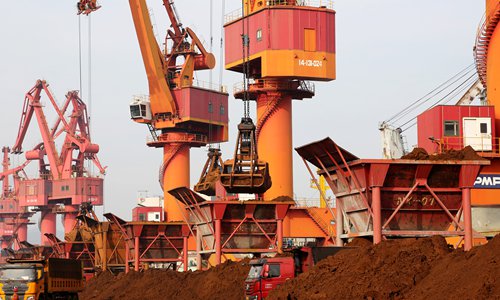HOME >> SOURCE
Enhanced cooperation benefits India, China: experts
By Ma Jingjing Source:Global Times Published: 2019/12/12 20:28:41
S.Asian country’s iron ore imports slump as GDP growth slows

Cranes unload imported iron ore at the Lianyungang Port in East China's Jiangsu Province on Sunday. In September, the port's iron ore throughput exceeded 6.5 million tons, a new high for the year, making it a major port for iron ore imports in China. Photo: VCG
India's low household savings rate and inability to deploy domestic resources are curbing the South Asian country's GDP growth, and Chinese experts said India should summon up the courage to step up cooperation with China.
As India's GDP third-quarter growth abruptly slowed to a six-year low of 4.5 percent, its imports of iron ore and concentrates tumbled nearly 99 percent year-on-year to 68.62 million rupees ($970,957) in October, data from India's Ministry of Commerce and Industry showed.
India's weak demand for iron ore is due to a slide in crude steel output, Wang Guoqing, research director at the Beijing Lange Steel Information Research Center, told the Global Times on Wednesday.
In October, India's production of crude steel was about 9.09 million tons, down 3.4 percent year-on-year, data from Lange showed.
Some Indian iron ore mines have accelerated production ahead of potential market disruption. India's The Economic Times website reported in November that the leases of 232 merchant iron ore mines in India will expire in March 2020, affecting about 25-30 percent of its iron ore production, citing Acuite Ratings & Research.
India has long been a net exporter of iron ore, but imports expanded after mining bans across the country, consulting firm McKinsey & Co said in a recent report. The consultancy forecast that India's imports of the raw material for steel may increase to 33 million tons in 2020, from imports of 16 million tons in 2018.
However, this is still far below China's imports of iron ore and concentrates in October alone, which stood at 92.86 million tons, or $8.7 billion.
The sharp contrast is also a result of the two countries being at different economic development stages, Zhao Jianglin, an expert on Southeast Asian affairs at the National Institute of International Strategy under the Chinese Academy of Social Sciences, told the Global Times on Thursday.
"India's infrastructure sector has developed slowly, mainly due to land acquisition problems and fund shortages for large-scale projects," Zhao said, noting that this situation curbs India's economic growth momentum.
As a major player in the world's infrastructure market, China can provide capital, talent and experience, Zhao said.
Between the launch of the Belt and Road Initiative in 2013 and the end of 2018, China directly invested more than $90 billion in countries along the initiative, an annual increase of 5.2 percent on average, according to a report on the Chinese government website gov.cn.
"China is willing to offer help to India, and welcomes India to join the Regional Comprehensive Economic Partnership," she said. However, India is afraid that it may have to trade off geopolitical strategies in order to guarantee domestic economic growth by strengthening cooperation with China.
It's time for India to show courage and consider China a partner, Zhao said, noting that cooperating with China will benefit both countries and even the whole Asia-Pacific region.
During the 3rd RCEP Summit held in Bangkok, Thailand in November, 15 nations concluded text-based negotiations, with a formal signing expected in 2020.
But one important economy, India, declined to join the agreement, worrying that it may "put its domestic industry and agriculture at risk," The Economic Times said in a separate report.
Posted in: ECONOMY